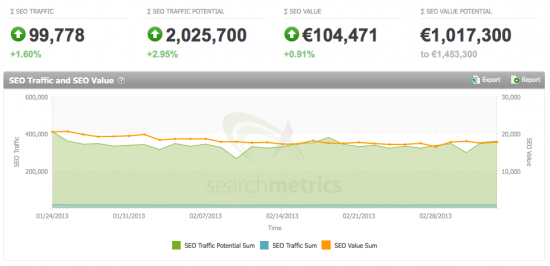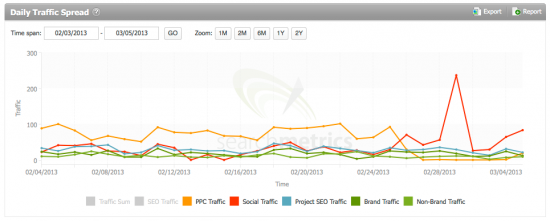In the “Big Data in SEO” article series, I guide you through the seven topics that are important for enterprise SEOs. The present article looks at how the ROI for online marketing projects can be measured using the Searchmetrics Suite.
In the end it’s always a question of money. Return on investment (ROI) is the currency used to measure the effectiveness of marketing activities, especially on the Internet. Although at first glance this may not always seem easy, a closer look shows that it is only a matter of collecting the right data, evaluating it and then deciding.
Search Engine Advertising vs. Search Engine Optimization
The two large online marketing tool boxes could hardly be more different from this perspective:
Search Engine Advertising (SEA):
- Quickly leads to tangible success (in terms of users and thus conversions).
- Very easy to measure.
- Largely follows understandable criteria.
Search Engine Optimization (SEO):
- A lot of somewhat uncertain influencing factors are involved, from OnPage (e.g. targeting, website structure, website performance) to OffPage (e.g. domain popularity, quality of links, diversity).
- Can be planned over the long term.
- Produces lasting results.
In a nutshell you could say that while SEA is comparable to classic performance marketing (and individual users are thus purchased), SEO is like investing over an extended period of time. Different measures are thus appropriate for different goals:
- For spontaneous or quick campaigns the only right “Google optimization” strategy may be to run AdWords ads.
- Even when there is very high conversion or strong competition in a given market niche, SEA is sometimes the method of choice.
- However, the more economical solution for “normal topics” in the long term is usually organic search engine optimization. The reason is that once a good ranking has been achieved, the cost of maintaining it is relatively low.
The ideal approach is to combine SEO and SEA in a growth spiral: while the organic optimization ranking is getting up to speed, SEA campaigns can already generate sales. Once organic rankings have improved, the AdWord budget can be used to carve out a new market niche. Extremely competitive topics – for which an organic approach can hardly be expected to yield a good position – will always require running an ongoing PPC campaign in any case.
Easy to calculate: the ROI for SEA
The ROI calculation in the AdWords area is relatively easy. The arithmetic involved is simple: as long as users cost less than their conversion into customers, advertising can be scaled without hesitation.
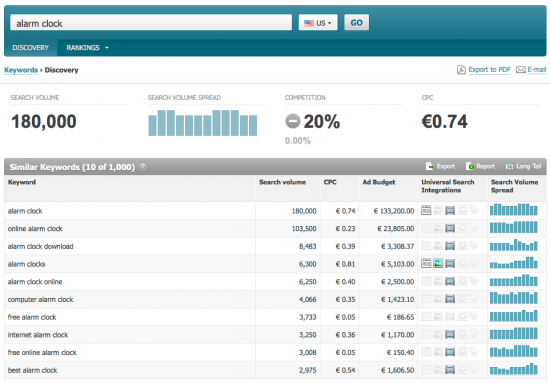
An example: According to our data, the keyword “alarm clock” costs € 0.74. If my website page has a conversion rate of 10 percent and I can make € 7 per alarm clock sold, I will make € 70 for every 100 visitors and pay Google € 74 for it. This is not a scalable business model. However, if I can achieve the same conversion and the same yield with users who come across the keyword “best alarm clock”, I pay € 54 for 100 visitors and make a profit of € 16. The deal is worth it!
Complex: the ROI for SEO
This is far more complicated with organic optimization. Calculating costs alone is already difficult – since good SEO measures also support conversion through, for example, improvement in performance or internal linking or because real users land on site via the established links. However, that is a luxury problem that we get a handle on. Now the question of the returns has to be clarified: for SEO measures do not ensure sales immediately, but rather always after a certain period of time. Whoever makes it to first place on Google with his money keyword will probably stay there for a while.
So: How much is a top position for a keyword worth?
A question that will be answered in the Searchmetrics Suite on the basis of the PPC data:
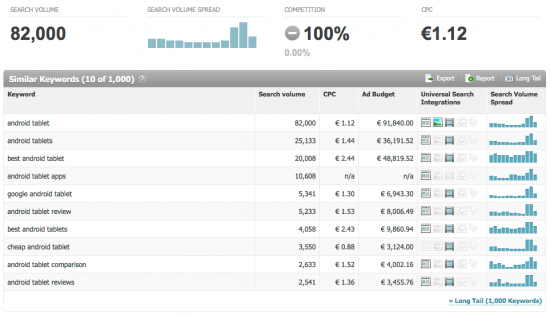
Whoever wants to get to first place with the search term “Android tablet” should have an advertising budget of € 91,840. He will then be in first place with 82,000 searches and have to pay € 1.12 per click. These are approximate values of course – but values that are close and specific enough for further calculation.
However, we can do even better: we calculate, of course, not only the value of a top ranking in first place, but can even deduce the potential traffic for a slightly lower placing. And that is why all SEO rankings for a domain can be converted into money:
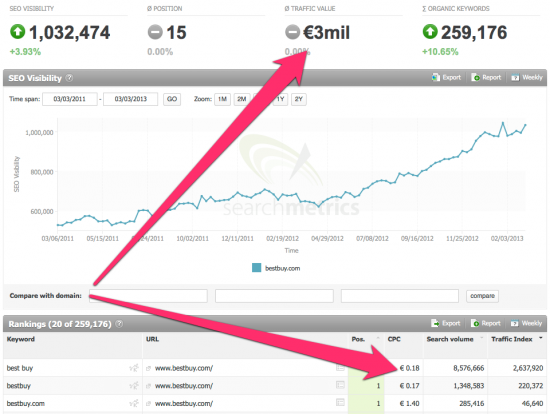
The sum of all the individual values for each keyword (Traffic Index * CPC) results in € 3 million/month for this domain.
And the ROI of an SEO campaign? This must be calculated over a period of several months. Were it possible, for example, to increase the SEO value of the above domain from € 3 million/month to € 3.1 million/month for a given SEO project, you could fix the period for reinvestment at 6 months and would have 0.6 million Euros of increased advertising volume. This would, of course, still have to be set off against the conversion (as in the case above, about 10%). A return of € 60,000 would thus be left over. If this value is higher than the estimated costs, the measure should definitely be implemented, since you are then in the “green ROI range”.
Realizing the potential
However, before rushing to open up a new topic in the shop on the basis of this calculation, it is important first to tap the potentials. After all, almost every page has great rankings – which, however, are still just out of the user’s line of sight. We offer a comprehensive report in the traffic area for this purpose:
SEO traffic is the calculated amount of users who land on the site via organic measures. There is, of course, much more potential. It is being assumed here that you would be in first place for every keyword. The two other large figures above indicate this in the Internet currency “sales”. Further on in the report all the assigned keywords are shown with detailed information on how much traffic and sales could be possible for each keyword. Of course tapping the full potential is nearly impossible. However, if there is a very large spread between “actual” and “potential” it is worth fishing in this pond.
Tip: These are all calculated estimates of course. If you want or need more exact information, you can connect your Web analytics tool (e.g. SiteCatalyst, Google Analytics or eTracker) with the Searchmetrics Suite and receive the precise, unadulterated numbers with respect to traffic.
Stick to it and track results
Whether you invest in PPC campaigns, SEO measures, or both, you should, of course, not forget to track the results. And what could handle that better than our SEO tracking? Here’s an example: PPC traffic is greatly reduced and at the same time more than compensated by a social traffic campaign:
Two “fast” online marketing measures were thus combined here, but that is meant to serve as a good example of the fact that the ROI for SEO and PPC measures can be calculated very precisely – and should be!
Next week we will show you more about: Optimizing processes: saving time and money.
Series: How top companies handle big data in SEO
On our website you can get the complete Big data-series as complete eBook. Download now!
- Promoting productivity: managing international teams and agencies. Large quantities of data require a very fine allocation of rights. For reasons of data protection on the one hand, but also for quality reasons: If everyone can do whatever he or she wants to, you end up not really knowing what’s inside the big data pot. The Suite allows you to perform these tasks in a simple and user-friendly way thanks to the allocation of rights.
- Quick overview: managing different campaigns in a structured way. Large companies always pursue multiple goals at one time. These goals can be pursued individually using the features of the Searchmetrics Suite, such as tagging and multi-tagging. But the Suite also lets you adapt and automate every report and every chart.
- Observing competition: learning from your competitors. Competition is sometimes the biggest surprise in online marketing. Our offline competitors are potentially only marginal online competitors, whereas our offline partners are actually our toughest competitors. We provide just the right environment in numerous data pools.
- Pick the cherries: tapping into hidden potential. It’s not always worthwhile to work on the keywords with the largest number of searches. Competition, universal search and existing ranks also play an important part.
- Improving performance: technical optimization. Sometimes even the best SEO gets muddled up when dealing with a large page. We crawl every page and report error pages and optimization potential for keywords.
- Return on investment: paying attention to the conversion. Ultimately, it’s about the money. Is a PPC campaign worth it or would the budget be better allocated to SEO optimization. What’s more worthwhile? We supply figures to help you make this decision.
- Optimizing processes: saving time and money. One employee on the team needs a daily report, another one a monthly summary. Our reports are highly flexible, relevant and can be generated with just a few clicks.
So you see: There’s a lot to be done. Big data isn’t just marketing hype or a simple glance into a crystal ball filled with data. Big data is a necessary and effective way of working that is simply part of enterprise SEO and has to be learned. We help you with it. Stay tuned!

